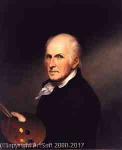Charles Willson Peale
Charles Willson Peale
Place: Chester
Born: 1741
Death: 1827
Biography:
, a prominent figure in American art and science, left an indelible mark on the country's cultural landscape. Born in Chester, Queen Anne's County, Maryland in 1741, Peale's life was a testament to his multifaceted nature - artist, soldier, scientist, inventor, politician, and naturalist.
Artistic Pursuits
Peale's artistic journey began with an apprenticeship under John Hesselius and John Singleton Copley. He later studied in England under Benjamin West, refining his skills for three years starting from 1767. Upon returning to America, Peale settled in Annapolis, Maryland, where he not only honed his craft but also taught painting to his younger brother, James Peale, who would eventually become a noted artist.
- Charles Willson Peale's most celebrated works include portraits of leading figures from the American Revolution.
- His first portrait of George Washington, executed in 1772, marked the beginning of a long-standing collaboration, resulting in nearly sixty portraits of the first U.S. President.
- The Staircase Group, a double portrait of his sons Raphaelle and Titian, painted in the trompe l'oeil style, is another notable piece in Peale's repertoire.
Scientific Contributions and Museum Establishment
Peale's interest in natural history led to the organization of the first U.S. scientific expedition in 1801. This passion, combined with his artistic expertise, culminated in the founding of Peale's American Museum, later known as the Philadelphia Museum. The museum housed a diverse collection of botanical, biological, and archaeological specimens, including a large variety of birds that Peale himself acquired and mounted, having taught himself taxidermy.
Legacy and Remembrance
Today, Charles Willson Peale's legacy can be experienced through various institutions, including the Wikioo.org's Charles Willson Peale Collection, which features an array of his artworks. For a deeper understanding of Peale's life and contributions, visit Wikipedia's Charles Willson Peale page.
- Explore Peale's American Museum's history and its significance in the context of American scientific expeditions.
- Discover more about Charles Willson Peale's artistic techniques and influences on Wikioo.org's Charles Willson Peale: Margaret Strachan (Mrs. Thomas Harwood) page.
Conclusion
Charles Willson Peale's multifaceted life serves as a testament to the interwoven nature of art, science, and politics in 18th-century America. Through his pioneering spirit and artistic legacy, Peale continues to inspire generations, offering a unique window into the country's formative years. Visit Wikioo.org for more on Charles Willson Peale.
Wikipedia link: Click Here














